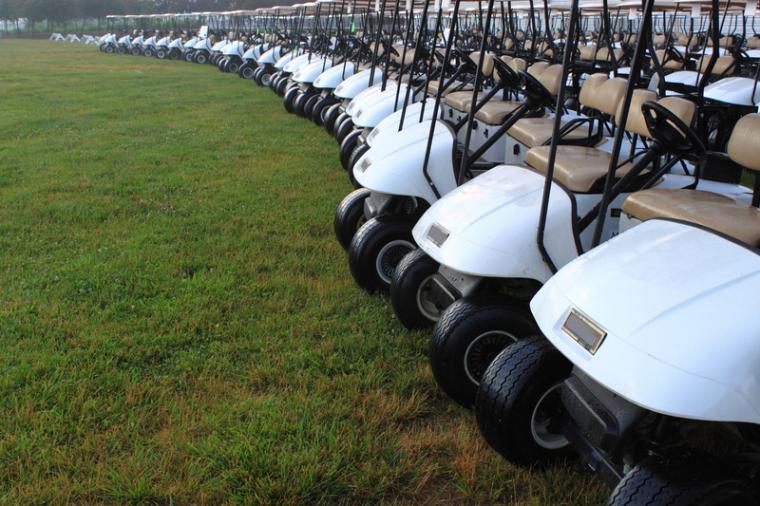

This calls for WAY more than a golf clap.
Few sports encourage get you outside as fun and safely as golf, and the latest participation figures released by the National Golf Foundation suggest the sport’s popularity has shot upwards.
In fact, the NGF reports that a record three million people played on a golf course for the first time last year. That breakthrough came after seven straight years of more than two million beginners per year and doubled the number of beginners in 2011. Additionally, one of the sport’s largest demographic groups is now 18- to 34-year-olds, with 5.9 million young adults participating on courses in 2020 and another five million taking part in off-course activities at driving ranges, indoor golf simulators or golf entertainment venues such as Topgolf and Drive Shack.
Approximately 6 million female on-course golfers (adults and juniors) played the game last year, an increase of about 450,000. Today, almost one-quarter of all on-course golfers are women, and more than one-third of all junior golfers are girls compared to just 15 percent in 2000. And more than one-quarter of junior players are non-Caucasian; 20 years ago, only 6 percent were non-Caucasian.
All told, 36.9 million Americans played on-course and/or off-course golf in 2020, and golf’s overall reach — which includes playing, watching or reading about the sport — is estimated to be 101 million people (or one out of every three Americans over 6 years old).
“There hasn’t been this much optimism and new activity in the golf business since the turn of the century,” Joe Beditz, NGF president and chief executive officer, said in a recent email to federation members, as reported by golfdigest.com. “Spring shutdowns gave way to an unprecedented summer and fall in terms of play, golfer introductions and reintroductions, and robust, late-season spending.”
And if the sport is included in the Paralympic Games in Los Angeles in 2028, that will further fuel its aspirational momentum.
While many people took up the sport in quarantine, it’s far from a fad – players are sticking with it, apparently and working to improve their game in 2021.
Golf courses in Maryland are reportinga 10-fold increase in play, for example, and it’s “almost impossible to get a tee time”on some of the top-rated courses in Wisconsin — where the 2021 Ryder Cup returned to the United States in September for the first time since 2016, at Whistling Straits Golf Course in Kohler, Wis.
Here’s more from the golfdigest.com report:
The net gain in golfers … contributed to a healthy boost in rounds played, despite many states restricting or even banning play for weeks or months. The NGF estimated a loss of 20 million rounds in the spring with course closures and restrictions, but by year’s end, 502 million rounds were recorded. That was 61 million more than in 2019, nearly a 14 percent increase and the largest one-year gain other than in 1997 when Tiger’s booming popularity saw a 63-million-round increase.
The NGF research indicates that the biggest driver of the rounds played surge wasn’t exclusively new golfers. Rather, it was the “core golfers” (more than eight rounds a year) who really upped their games. The report cites “a passionate cohort of existing players (roughly 20 percent of the core-golfer population)” who fueled the boost in the average rounds played per golfer to 20.2. It marked an all-time high since the statistic started being tracked in 1998. Despite being the age groups most at risk health-wise, older players still played the most golf. Those aged 60-69 logged an average of 29 rounds in 2020, while those golfers 70 and over played an average of 40 times last year. However, millennials (those aged 18-34) increased their rounds played by 13 percent compared to 2019, and 44 percent of all those who played golf at least once on a golf course in 2020 were under the age of 40—with as many under the age of 30 as over the age of 60.
Private clubs clearly were a beneficiary. According to the NGF, two thirds of private clubs said they were in good financial health in late 2020, and rounds at private clubs saw almost a 20 percent increase, greater than what was seen at public facilities, which were up 12 percent. Those gains came despite the reduced rounds at resorts after 2020 saw much less travel. In a way, the private club may have benefited as the stay-cation alternative.
All of this increased interest in golf is wreaking havoc on the golf club supply chain for irons, drivers, putters and even grips, according to businessinsider.com, citing reporting by bloomberg.com: “Custom-fit clubs are taking upwards of 12 weeks to arrive rather than 10 days. Titleist’s parent company Acushnet has warned of ongoing supply chain disruptions. And golf equipment maker Mizuno told Bloomberg it went from expecting to have a surplus of leftover inventory to ‘practically having no inventory at all.’”
Despite the supply delays, PGA of America is encouraging several ways for children and their families to get involved in the sport. They range from golf entertainment venues and miniature golf to teeing off at practice ranges and in family scrambles. “Unlike an on-course experience, the kids can get 10 times the activity in a good range session versus nine holes,” according to the PGA. “Golf doesn’t always have to be a competition. … Golf is popular because it is a positive social activity.”

